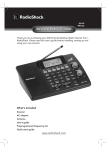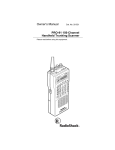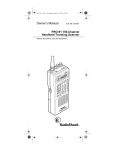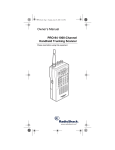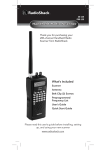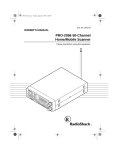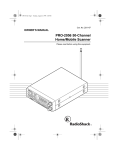Download Radio Shack PRO-91 Specifications
Transcript
PRO-2046 Programmable 100-Channel Mobile Scanner (200-0149) Introduction Your new RadioShack PRO-2046 Programmable 100-Channel Mobile Scanner lets you in on all the action! This scanner gives you direct access to over 30,000 exciting frequencies, including those used by police and fire departments, ambulance and transportation services, aircraft communications, government agencies, and amateur radio services. You can select up to 100 channels to scan and you can change your selections at any time. Your scanner is preprogrammed with service search banks for convenience. By pressing a single button, you can quickly search those frequencies most widely used by public service and other agencies without tedious and complicated programming. The scanner also lets you group special or interesting frequencies into their own set of channels. Compact and versatile, the scanner mounts in your home or vehicle. You can also connect an external speaker to your scanner, or an AC adapter and base station antenna (not supplied) to set the scanner up as a base station in your home. Your scanner has these features: HyperScan - lets you scan 50 channels or more per second. Hypersearch - lets you set the scanner to search at up to 300 steps per second in frequency bands with 5 kHz steps, to help you quickly find interesting broadcasts. Four Service Search Banks - lets you Search preset frequencies in separate police/fire/emergency, Department of Transportation, highway services, and public service banks, to make it easy to quickly identify calls. You can select and search one or more banks at a time. Data Detection - while scanning channels or searching, you can set the scanner to detect non modulated carriers or data signals, such as preamble signals for pagers, to keep the scanner from stopping on these frequencies. Weather Band Key - scans seven preprogrammed weather frequencies to keep you informed about current weather conditions. Ten Channel Storage Banks - You can store 10 channels in each of 10 banks to group channels so calls are easier to identify. Ten Monitor Memories - you can store 10 frequencies located during a frequency search, so you can decide if you want to move them to permanent channel storage Ten Priority Channels - lets you set the scanner to check up to 10 channels every 2 seconds so you do not miss important calls. Nine Frequency Bands - lets you quickly and easily search preset frequency ranges, so you can find new and unlisted broadcasts. Two Frequency Band Search - you can search upward or downward through the Options preset frequency bands (band Search) or Search by starting from a specified frequency (direct search). Frequency Skip - lets you select up to 20 frequencies for the scanner to skip during a search, so you can search more efficiently. Two-Second Channel - lets you set the scanner so it delays scanning Scan/Search Delay or searching for 2 seconds before moving to another channel, so you can hear more replies. Key Confirmation Tones - the scanner sounds a tone when you perform an operation correctly, and sounds an error tone if you make an error. Memory Backup - keeps channel frequencies stored in memory for 14 days or more during a power loss. Lock Out Function - keeps channels you select from being scanned, so you can skip over busy channels such as those with a continuous transmission. Squelch Control - lets you adjust the scanner's sensitivity to either help the scanner receive weak signals or help eliminate receiver noise when the scanner is not receiving a signal, so you can hear calls instead of static. Backlit Display - makes it easy to view and change programming information at any time. Your Pro-2046 scanner can receive all of these bands: 29-54 MHz (10-Meter Amateur Radio, VHF Lo, 6-Meter Amateur Radio) 108-136.9750 MHz (Aircraft) 137-174 MHz (Government, 2-Meter Amateur Radio, VHF Hi) 406-512 MHz (UHF Lo, 70-Centimeter Amateur Radio, Government, UHF "T" Band) 806-823.9375 MHz (UHF Public Service) 851-868.9375 MHz (UHF Hi) 896.1125-956 MHz (UHF Hi, 33-Centimeter Amateur Radio) In addition, your scanner is preprogrammed with these weather service channels. 162.400 MHz 162.475 MHz 162.425 MHz 162.500 MHz 162.450 MHz 162.525 MHz 162.550 MHz We recommend you record your scanner's serial number here. on the scanner's back panel. The number is Serial Number: _________________________________ FCC Notice Your scanner might cause TV or radio interference even when it is operating properly. To determine if your scanner is causing interference, turn off your scanner. If the interference goes away, your scanner is causing it. Try to eliminate the interference by: Moving your scanner away from the receiver. Connecting your scanner to an outlet that is on a different electrical circuit from the receiver. Contacting your local RadioShack store for help. If you cannot eliminate the interference, the FCC requires that you stop using your scanner. This device complies with Part 15 of the FCC Rules. to the following two conditions: Operation is subject (1) this device may not cause harmful interference, and (2) this device must accept any interference received, including interference that may cause undesired operation. Scanning Legally It is legal to listen to almost every transmission your scanner can receive. However, there are some electronic and wire communications that are illegal to intentionally intercept. These include: Telephone conversations (cellular, cordless, or other private means of telephone signal transmission). Pager transmissions. Scrambled or encrypted transmissions. According to the Federal Electronic Communications Privacy Act (ECPA), as amended, you could be fined and possibly imprisoned for intentionally intercepting, using, or disclosing the contents of such a transmission unless you have the consent of a party to the communication (unless such activity is otherwise illegal). These laws change from time to time and there might be state or local laws that also affect legal scanner usage. Special Features Faxback Doc. # 46802 Delay Many agencies use a two-way radio system that might have a pause of several seconds between a query and a reply. Your scanner's delay feature causes it to wait for 2 seconds after each transmission on a channel before it resumes scanning or searching. To program a 2 second delay for a channel you select, manually select the channel then press DELAY until DLY appears. To program a 2 second delay for a channel while scanning, quickly press DELAY when the channel appears on the display. DLY appears. To turn off delay on any active channel, press DELAY when the channel appears on the display. DLY disappears. Skipping Frequencies/Channels You can scan channels and search for frequencies faster by skipping ones that have a continuous transmission, such as a weather channel. You can skip up to 20 frequencies during a band, direct, or service bank search, and you can skip all channels. To skip a channel/frequency while scanning or searching, press L/OUT/S/S when the scanner stops on it. Removing Skip from Frequencies To remove the skip from a frequency while searching, press 91-100/0 to stop the search, press /\ or \/ to select the skipped frequency, then press L/OUT/S/S until L/O disappears from the display. To remove the skip from all frequencies at once while searching, press and hold down L/OUT/S/S until the scanner beeps twice. Notes: If you skip more than 20 frequencies, each new frequency replaces earlier ones, starting from the first stored frequency. You can manually select skipped frequencies after you press 91/100/0 to stop a search. The scanner displays L/O when you select a skipped frequency. Removing Skip from Channels To remove the skip from a channel while scanning, press MANUAL to stop the scan, use the number keys to enter the channel number, then press L/OUT/S/S until L/O disappears from the display. To remove the skip from all channels at once while scanning, select the banks containing the locked channels, press MANUAL, then press and hold down L/OUT/S/S until the scanner beeps twice. Priority The priority feature lets you scan through programmed channels and still not miss important or interesting calls on specific channels. You can program one stored channel to each bank as a priority channel (up to 10 stored channels). As the scanner scans each bank, it checks that bank's priority channel every 2 seconds for activity. Notes: You cannot use the priority and data detection features at the same time (see "Detecting Data Signals" below). You can skip priority channels. If you skip all priority channels, the display shows P CH LOC OUt when you turn on the priority feature. See "Skipping Frequencies/Channels" above. The priority feature must be turned off to listen to monitor memories. The scanner automatically designates the first channel in each bank as that bank's priority channel. Follow these steps to program a different channel as the priority channel. 1. Use the number keys to enter the channel number you want to program as the priority channel, then press PRIORITY/H/S. P appears on the display to the right of the channel number. 3. Repeat Steps 1-2 for each channel you want to program in a bank as a priority channel. 4. To confirm all priority channel numbers for all banks, press PROGRAM then repeatedly press PRIORITY/H/S. To turn on the priority feature, press PRIORITY/H/S during scanning. PRI appears on the display and the scanner checks the priority channel in each selected bank every 2 seconds. It stays on the channel if there is activity, and P appears on the display. To turn off the priority feature, press PRIORITY/H/S. the display. Note: PRI disappears from If you are scanning more than one bank in which a priority channel has been programmed, the scanner stops on the lowest-numbered priority channel first while scanning. Changing The Search Speed You can adjust your scanner's search speed. You can set the scanner to search at either 100 steps per second (normal search speed) or 300 steps per second (HyperSearch speed). Note: You can use the HyperSearch speed only in 5 kHz-step bands. "Band Mode and Frequency Step" below). (See To select the HyperSearch speed during a band or direct search, press PRIORITY/H/S. SRCH flashes on the display. Detecting Data Signals You can set the scanner to detect un-modulated carriers or data signals (such as preamble signals for pagers) during scanning, band search, direct search, or service bank search. Note: You cannot detect data signals in the air band (AM mode). See "Band Mode and Frequency Step" below. To detect data signals, press and hold down DATA until DATA appears on the display. If the scanner pauses on a transmission and detects a data signal, it resumes searching in 2 or 3 seconds. To stop detecting data signals, press DATA until DATA disappears from the display. Note: You cannot use DATA and PRIORITY at the same time. (See above.) Listening To The Weather Band The FCC (Federal Communications Commission) has allocated 11 channels for use by the National Oceanic and Atmospheric Administration (NOAA). NOAA broadcasts your local forecast and regional weather information. We have preprogrammed your scanner with seven of the U.S. frequencies available to NOAA. To scan the preprogrammed weather channels, press WX/E. WX appears on the display, and the scanner searches through the weather band and stops on an active broadcast. If a broadcast is weak, press WX/E again to continue to search through the weather band. Note: For a list of all 11 national weather frequencies, see "National Weather Frequencies" in Faxback Doc. # 17653. Band Mode and Frequency Step The scanner scans in the following band modes: AM (amplitude modulation) - used in aircraft bands. NFM (narrowband frequency modulation) - used in action bands such as police, fire, ambulance, Amateur Radio, etc. This table shows the preset band modes and frequency steps your scanner uses for each frequency range. Freq. Range (MHz) Band Mode Freq. Step (kHz) 29.000-54.000 ................. NFM ................................... 5 108.000-136.975 ................ AM ................................. 12.5 137.000-144.000 ................ NFM ................................... 5 144.000-148.000 ................ NFM ................................... 5 148.000-174.000 ................ NFM ................................... 5 406.000-450.000 ................ NFM ................................ 12.5 450.000-470.000 ................ NFM ................................ 12.5 470.000-512.000 ................ NFM ................................ 12.5 806.000-956.000 ................ NFM ................................ 12.5 Note: The band modes and frequency steps are preset. them. You cannot change Operation Faxback Doc. # 46801 Turning On The Scanner/Setting Volume and Squelch 1. Turn SQUELCH and VOLUME fully counterclockwise. 2. Turn VOLUME clockwise until you hear a hissing sound. 3. Turn SQUELCH clockwise, then leave it set to a point just after the hissing sound stops. Notes: If the scanner picks up unwanted, partial, or very weak transmissions, turn SQUELCH clockwise to decrease the scanner's sensitivity to these signals. If you want to listen to a weak or distant station, turn SQUELCH counterclockwise. If the scanner will not scan, turn SQUELCH further clockwise. Resetting The Scanner You might need to reset the scanner if any of the following occur: The scanner's display locks up. The scanner does not work properly after you connect power. The scanner is dropped or subjected to a physical or electrical shock. CAUTION: This procedure clears all the information you have programmed into the scanner! Use this procedure only when you are sure your scanner is not working properly. 1. Turn off the scanner. 2. While you press and hold down 11-20/2 and 81-90/9, turn on the scanner. Scanning Channels To scan the stored channels, press SCAN. The scanner scans through all non-locked channels in the active banks (see "Scanning Channel-Storage Banks" below and "Skipping Frequencies/Channels" in Faxback Doc. # 46802). Searching Banks To search one or more of the service search banks, press any or all of these buttons. POLICE FIRE-EMG DOT HWY PUBLIC SVC This indicator for each service search bank you selected appears on the display, and the scanner searches through all non-skipped channels (see "Skipping Frequencies/Channels" in Faxback Doc. # 46802) in the bank(s) you selected. The active banks indicator blinks on the display. The scanner searches the frequencies within the active bank from the lowest to the highest frequency. If the scanner detects a broadcast on a frequency, it stops on that frequency. When the broadcast ends, the scanner continues to search higher frequencies in the bank. When the scanner finishes searching all frequencies in the bank, it does either of the following: Returns to the lowest frequency in the bank and starts searching again (if you selected only one bank). Searches the frequencies in the next bank you selected (if you selected more than one bank). To turn off a service search bank, press the button until its indicator disappears from the display. Note: There must be at least one active search bank. all search banks. You cannot turn off Scanning Channel Storage Banks Note: You cannot scan a channel-storage bank until you have stored frequencies in it. See "Storing Frequencies into Channels" below. To select one or more channel storage banks while scanning, select each bank you want to scan by pressing its number key until the bank's number appears on the display. The scanner scans through all non skipped channels (see "Skipping Frequencies/Channels" in Faxback Doc. # 46802) in the bank(s) you selected. To turn off channel storage banks, press the number key for the bank(s) until the bank's number disappears. The scanner does not scan any of the stored channels within banks you have turned off. Note: You can manually select any channel in a bank, even if the bank is turned off. Storing Frequencies into Channels You can store up to 100 frequencies into your scanner's channels. Good references for active frequencies are RadioShack's "Police Call Radio Guide Including Fire and Emergency Services," "Aeronautical Frequency Directory" and "Maritime Frequency Directory". We update these directories every year, so be sure to get a current copy. See also "Guide to the Action Bands" in Faxback Doc. # 17653. If you do not have a reference to frequencies in your area, follow the steps in "Searching Frequency Bands" or "Searching Service Search Banks" below to search for transmissions. 1. If the scanner is scanning, press MANUAL. 2. Using the number keys, enter the channel number where you want to store a frequency. 3. Press PROGRAM BANK and the bank number, the selected channel number, any previously stored frequency and PGM appear on the display. Note: 4. Using the number keys, enter the frequency you want to store into that channel, including the decimal point. Note: 5. Your scanner automatically rounds the entered frequency up to the closest valid frequency. For example, if you try to enter a frequency of 151.473, your scanner accepts it as 151.475. Press WX/E to store the frequency. Note: 6. If no frequency has been stored in the selected channel, 000.0000 MHz and L/O appear on the display. If you enter an invalid frequency in Step 4, the scanner displays Error. Press CLEAR/., then repeat Steps 4 and 5. To program the next channel in sequence, repeat Steps 3-5. another channel (not in sequence), repeat Steps 2-5. To program Searching Frequency Bands You can search for transmissions within any of the scanner's nine frequency bands, then temporarily store them into monitor memories. Band Search You can select a frequency band and search for transmissions within that band. Note: 1. You can use the scanner's delay feature while using band search. See "Delay" in Faxback Doc. # 46802. Repeatedly press BAND until you see the frequency band you want to search. The scanner displays SRCH and the range for the frequency band, and the number of the current monitor memory blinks on the display. Then the scanner displays -b- (band) and SRCH /\ or \/ SRCH, and starts to search the frequencies in the band. When the scanner finds a transmission, it stops and displays the frequency's number until the transmission stops, then it starts searching again. 2. To manually search the band, press 91-100/0 after the scanner starts automatically searching the frequencies. The scanner displays -H-, SRCH /\ or \/ SRCH, and a frequency within the band you selected. Repeatedly press /\ to search from the lower to the upper range, or \/ to search from the upper to the lower range. Press and hold down /\ or \/ or press 91-100/0 to return to automatic search. 3. When the scanner finds an active frequency you can do any of the following: To save the frequency into the current monitor memory, press MON. To continue searching, press /\ or \/. To stop searching and listen to the frequency, press 91-100/0. -H- (hold) appears on the display. To continue automatic searching after you stop a search, either press 91-100/0 or press and hold down /\ or \/ for about 1 second. Notes: You can change the direction of either an automatic or manual search by pressing /\ or \/ once. If you manually tune to a search skip frequency, the display shows L/O (see "Skipping Frequencies/Channels" in Faxback Doc. # 46802). Direct Search You can enter a frequency, then search for transmissions above or below that frequency within the frequency bands. Note: You can use the scanner's delay feature while using direct search. See "Delay" in Faxback Doc. # 46802. 1. Press MANUAL. 2. Use the number keys to enter the frequency you want to start the search from. Press CLEAR/. to enter a decimal point. 3. Press /\ or \/ to search up or down from the selected frequency. -d- (direct), SRCH, and /\ or \/ appear on the display, and the next available monitor memory number flashes. Note: If you enter an invalid frequency in Step 2 and the scanner displays Error, press CLEAR/. then repeat Steps 2 and 3. 4. When the scanner finds an active frequency, you can do any of the following: To save the frequency into the current monitor memory, press MON. To continue searching or change the search direction, press /\ or \/. To stop searching and listen to the frequency, press 91-100/0. -h- (hold) appears on the display. To continue searching after you stop a search, either press 91-100/0 or press /\ or \/ for about 1 second. Note: If you manually tune to a search skip frequency or 000.0000, the display shows L/O (see "Skipping Frequencies/Channels" in Faxback Doc. # 46802). Searching Service Search Banks 1. To search one or more service search banks, press any of these buttons: POLICE FIRE-EMG DOT HWY PUBLIC SVC The indicator for each search bank you selected appears on the display and the scanner searches through all non-skipped channels (see "Skipping Frequencies/Channels" in Faxback Doc. #46802) in the bank(s) you selected. When the scanner finds a transmission, it stops on that frequency. 2. When the scanner finds an active frequency, you can do any of the following: To save the frequency into the current monitor memory, press MON. To continue searching or change the search direction, press /\ or \/. To stop searching and listen to the frequency, press 91-100/0. -H- (hold) appears on the display. To continue searching after you stop a search, either press 91-100/0 or press and hold down /\ or \/ for about 1 second. Note: If you tune to a locked-out channel, the display shows L/O (see "Skipping Frequencies/Channels" in Faxback Doc. # 46802). Listening To Monitor Memories After you temporarily store frequencies into the scanner's monitor memories, you can listen to them by pressing MANUAL, MON, then the number for the monitor memory you want to listen to. Note: To listen to the monitor memories, the priority channel feature must be turned off (see "Priority" in Faxback Doc. # 46802). Moving a Frequency From a Monitor Memory To a Channel 1. If the scanner is scanning, press MANUAL. 2. Use the number keys to enter the channel number where you want to store the monitor frequency, then press PROGRAM. PGM appears on the display. 3. Press MON, then use the number keys to enter the monitor memory number that has the frequency you want to store into the channel. The channel number flashes, and MON and the frequency appear. 4. Press WX/E. number. The scanner stores the frequency in the selected channel Deleting a Frequency Follow these steps to delete a frequency from a channel. 1. If the scanner is scanning, press MANUAL. 2. Using the number keys, enter the channel number containing the frequency you want to delete. 3. Press PROGRAM 4. Press 91-100/0, then press WX/E. The frequency is deleted from the channel. To delete a frequency from a monitor memory, store a new frequency in the monitor memory. Manually Selecting a Channel You can continuously monitor a specific channel without scanning. This is useful if you hear an emergency broadcast on a channel and want to hear all the details (even though there might be periods of silence) or if you want to monitor only a specific channel or a locked-out channel. Follow these steps to manually select a channel. 1. Press MANUAL. 2. Use the number keys to enter the channel number you want to hear, then press MANUAL again. Notes: If your scanner is scanning and stops at the channel you want, simply press MANUAL to manually select the channel. If you repeatedly Press MANUAL, the scanner steps through the channels. PRO-2046 Programmable 100-Channel Mobile Scanner (200-0149) Specifications Faxback Doc. # 46805 Frequency Coverage: VHF Lo: ..................................... 29.7-50 MHz (in 5 kHz steps) Amateur Radio: .............................. 29-29.7 MHz (in 5 50-54 MHz (in 5 144-148 MHz (in 5 420-450 MHz (in 12.5 kHz kHz kHz kHz steps) steps) steps) steps) Aircraft: ............................ 108-136.975 MHz (in 12.5 kHz steps) Government: ................................. 137-144 MHz (in 5 kHz steps) Amateur Radio/Government: ................ 406-420 MHz (in 12.5 kHz steps) VHF Hi: ..................................... 148-174 MHz (in 5 kHz steps) UHF Lo: .................................. 450-470 MHz (in 12.5 kHz steps) UHF "T": ................................. 470-512 MHz (in 12.5 kHz steps) UHF Public Service: ................. 806-823.9375 MHz (in 12.5 kHz steps) UHF Hi: ............................. 851-868.9375 MHz (in 12.5 kHz steps) 896.1125-956 MHz (in 12.5 kHz steps) Operation Channels: ............ Any 100 channels in any band combinations (10 channels x 10 banks) and 10 monitor channels Sensitivity: ...................... (20 dB S/N with 60% modulation for AM: 3 kHz deviation for FM): 29-54 MHz: ................................................. 0.5 microV 108-136.975 MHz: ........................................... 2.0 microV 137-174 MHz: ............................................... 0.7 microV 406-512 MHz: ............................................... 0.7 microV 806-956 MHz: ............................................... 0.8 microV Selectivity: +/- 11 kHz: ..................................................... -6 dB +/- 15 kHz: ................................................... - 50 dB Direct Search Speed/Band Search Speed: Normal: ........................................... 100 Steps/Sec (Max) Hyper: ............................................ 300 Steps/Sec (Max) (only 5 kHz step band.) Scan Speed: ................................... 50 Channels/Sec. (Nominal) Priority Sampling: ............................................. 2 Seconds Delay Time: .................................................... 2 Seconds IF Frequencies: .................................... 10.85 MHz and 450 kHz Squelch Sensitivity: Threshold: ....................................... Less than 0.9 microV Tight: .................................. VHF Lo, Hi, UHF (S+N)/N 25 dB Aircraft (S+N)/N 15 dB Antenna Impedance: ............................................... 50 Ohms Audio Power: ............................................... 2.0 W Maximum Memory Backup (without power): ......................... 14 days (Minimum) Built in Speaker: ..................... 3 Inch (77 mm) 8 Ohm, Dynamic Type Power Requirements: Vehicle Battery: ........................................ 13.8 Volts DC AC Adapter: ............. 12-13.8 Volts DC (such as (Cat. No 273-1652C) DC Adapter: .................. 13.8 Volts DC (such as Cat. No 270.1534) Current Requirement: .............................................. 460 mA Dimensions (HWD): ....... 1.94 x 7.0625 x 7.375 Inches (49 x 179 x 187 mm) Weight: ............................................... 2 lbs 3 oz. (1 kg) Specifications are typical; individual units might vary. are subject to change and improvement without notice. Specifications















